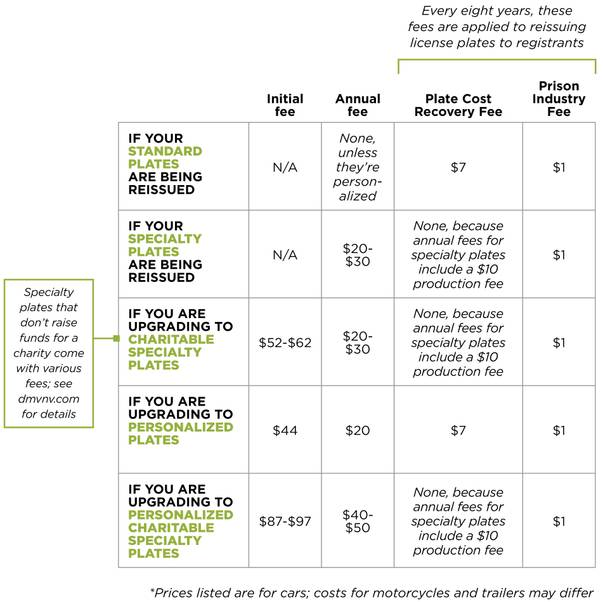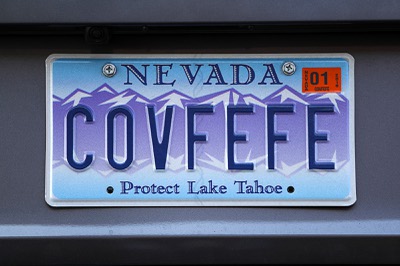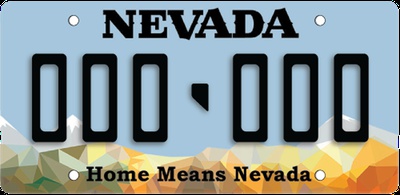$63 million
Approximate revenue brought in by Nevada specialty plates since 1998
Bumper stickers aren’t forever. And as of last summer, neither are most Nevada license plates.
A “rolling reissue” went into effect, aimed at swapping out hundreds of thousands of plates old enough to be faded, cracked and corroded to the point of hindering a quick read by law enforcement. Given how much wear comes with the cold up North and heat here in the South, state lawmakers in 2015 mandated a lifespan for license plates — eight years — with few exceptions.
We’re a little over a year into a three-year effort by the Department of Motor Vehicles to get through a backlog of reissues: approximately 720,000 plates (roughly 360,000 registrations) older than eight years. After that is handled, DMV officials expect about 200,000 plates (roughly 100,000 registrations) a year to be up for reissue. You might want to prepare for that notice in the mail, or just think about an upgrade.
‘Rolling reissue’ mechanics
The Nevadan who nabbed the COVFEFE plate
If forced to live in the theater of the absurd, I might as well jump on stage and embrace the madness.
That’s why I faxed — yes, faxed, because apparently we still do that in Nevada state government — a personalized license plate application for COVFEFE in late May. (If you forgot in the four months since President Donald Trump finished his two scoops of ice cream and tweeted it into the national consciousness: "Despite the constant negative press covfefe @realDonaldTrump, May 30, 2017, 9:06 p.m. PDT"
A tired typo of the word "coverage"? Likely. Yet the internet lit up over a typo punctuating yet another complaint about us evil media folks. And those seven letters fit perfectly on a Lake Tahoe plate like mine … and Tahoe is the only of Nevada’s 27 specialty plates that can hold seven letters. Esoteric news, Gallows humor, and $97 to help protect a national treasure?
Let’s do this.
Look, whatever your opinion of Trump, it is no alternative fact that we live inside a snow globe that flips and swirls without warning. It settles just long enough for Trump to tap out another tweet that shakes up the glitter in a colorful dazzle destined to disappear soon after. COVFEFE sparkled brighter than most. It rode the news cycle for a whole 24 hours. Take that, Obamacare!
Until last week, at least, when a young guy in a minivan yelled into my open window as we sat in traffic on Interstate 15 near Primm.
“Hey, great license plate!”
Thanks, friend. If the laugh improved your afternoon, then some good came of this COVFEFE we survived for at least one more day.
— Adam Candee
The year your plates turn 8, the DMV will include a notice on your mailed registration renewal card. If you renew through the website, a pop-up will notify you of the need for reissue. Either way you renew your registration, new plates will be sent to you automatically (decals arrive separately, so be sure to wait for the right plates). Old ones can be kept for sentimental reasons, though the DMV encourages recycling through its offices.
The aim of the “rolling reissue” is to swap out old plates that might be difficult for law enforcement to read. The visibility requirements are as follows:
• Day: Plates must be readable from a distance of 100 feet
• Night: Plates must be readable from 110 feet in standard headlights
Exemptions: A few classic or commemorative plates aren’t subject to the eight-year reissue cycle (because officials appreciate state pride and longtime-local cred).
• Blue plates manufactured from 1970 to 1981
• Circa 1982 Replica plates manufactured through 2015
• Nevada State Anniversary plates (125th and 150th)
If I have standard plates, will the new ones have a new number?
No, but they might have a new look.
Since 2001, the standard Nevada plate has featured the Sunset design, but last November the DMV introduced a new one called Home Means Nevada, “designed to reflect the unique diversity of the Silver State, from the dry desert landscape of Red Rock Canyon in Clark County, to the rich, green forest of Lake Tahoe and the stunning majesty of the Ruby Mountains. The base color of the plate symbolizes the iconic clear blue Nevada sky and wide-open spaces Nevada is known for worldwide.” Over the course of the reissue, the DMV has used up the remaining Sunset plates.
Details on specialty plates
What do they support?
Most specialty plates are tied to registered nonprofits, as the plates must generate money for community services related to education, public health or general welfare. Custom backgrounds show your support for causes put forth by the sponsoring organizations. The current mix offered by the Nevada DMV includes variations on a theme (Animal Appreciation, Conserve Wildlife, Support Wildlife), advocacy issues (Citizenship Project, Missing and Exploited Children) a few niche nods (Great Reno Balloon Race) and more. Buying the plate is a way of donating. If you pick a Red Rock Canyon plate, for example, Friends of Red Rock will receive $25 of your $62 initial fee and $10 of your $30 annual fee to support community initiatives.
How many options are there?
• There is a cap on the number of specialty designs in the lineup at any given time. In the first tier, it’s 30. To stay viable, these plates must draw and maintain at least 1,000 active registrations.
• The DMV tallies them by Oct. 1 each year and warns sponsoring organizations if their plates are in danger of being discontinued. After a final tally at the end of the year, plates below the mark are pulled from the lineup as of Jan. 1.
• But they’re not gone forever. At least, not for those who had them before they were discontinued. When these plates reach the end of the eight-year cycle, registrants are reissued the same specialty design they currently possess — including “old-style” Agriculture, UNLV and UNR designs.
• The second tier is capped at five, though all five proposed plates on the DMV’s list are still in the development pipeline (three have been recommended for approval and are expected to be released in 2018). Spokesman Kevin Malone said the second tier was created for groups not keen to wait for a spot to open on the first tier. There are two differences that don’t affect consumers: 1. Second-tier applications must include a $20,000 surety bond, compared with $5,000 bonds for first-tier applications. 2. Second-tier plates must maintain 3,000 active registrations to stay viable.
Who’s in the queue?
Malone said that each year, one or two plates fall out of the lineup. So you might see these on the road in the near future.
First Tier (from first in line):
• Sparks Heritage Foundation and Museum
• Desert Conservation Program
• Interfaith Council of Southern Nevada
• Grant a Gift Autism Foundation
• Northern Nevada Section of the Society of Mining, Metallurgy and Exploration
• Clark County Public Education Foundation dba The Public Education Foundation
• Food Bank of Northern Nevada
• United States Olympic Committee Sky Tavern Junior Ski Program
• National Association of Social Workers
• Opportunity Village ARC
• Second Amendment — NV Firearms Coalition
• Battle Ship Nevada Remembrance Project
*Applicants for the Second Tier, with those already recommended for approval in bold:
Keep Memory Alive/Cleveland Clinic Lou Ruvo Center for Brain Health; Women’s Resource Medical Centers of Southern Nevada; Hidden Valley Wild Horse Protection Fund; Southern Nevada Joint Management and Culinary and Bartenders Training Fund; Henderson Historical Society
Are there any restrictions on content?
Notable reject
In 2002, a design put forth by the charitable foundation of the Nevada Test Site (now the Nevada National Security Site) was rejected by the DMV, as the mushroom-cloud imagery commemorating atomic tests that took place near Las Vegas was found to be “insensitive to the times,” given fears of terrorism and nuclear waste.
Specialty plates “may not promote, advertise or endorse any specific product, brand name or service, or promote any specific religion, faith or anti-religious belief.” However, there has been conflict over what compliance looks like. In late 2015, for example, a pro-life design from the Women’s Resource Medical Centers of Southern Nevada drew opposition from Nevada Advocates for Planned Parenthood Affiliates, which sent a letter of concern to the Nevada Commission on Special License Plates about the pointedly religious nature of the WRMC’s mission statement. However, the plate was recommended for approval and is in the initial phase of design, which Malone said would have to meet statutory requirements.
Once a plate proposal is approved by the Nevada Commission on Special License Plates:
1. Sponsoring group meets with DMV for guidelines on character placement, acceptable colors and other elements.
2. Group submits formal proposed artwork to DMV, which can ask for changes. Once they agree on a design, the department makes prototypes.
3. Prototypes are reviewed by the Nevada Highway Patrol, including field-testing for legibility.
4. DMV reviews and can reject or give final approval.
5. With final approval, production begins.
6. Plates are distributed to field offices, posted on the DMV site and sometimes placed in office display cases.
7. As a portion of sales revenue goes to sponsoring organizations, the commission conducts an annual review. Organizations are required to submit a balance sheet and bank statement for the fiscal year, as well as a recent tax return and a breakdown of how money raised by the plate was spent. An audit can be requested, and any findings of “improper financial administration” may lead to a recommendation that the plate be discontinued. The DMV makes the final call.





Join the Discussion:
Check this out for a full explanation of our conversion to the LiveFyre commenting system and instructions on how to sign up for an account.
Full comments policy